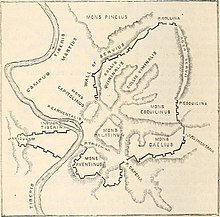Porta Caelimontana


The Porta Caelimontana or Celimontana was a gate in the Servian Wall on the rise of the Caelian Hill (Caelius Mons).[1] The Via Caelimontana ran from it; in the late 19th and early 20th centuries, Roman tombs were discovered along its southern edge, some of which have disappeared.[2]
The gate was rebuilt during the principate of Augustus.[3] According to an inscription, the Arch of Dolabella was built in the area in AD 10, during the consulship of Dolabella and Silanus, but there is disagreement over whether this arch was the reconstruction of the Porta Caelimontana.[4] The arch was incorporated into the support structure for the branch aqueduct of the Aqua Claudia built during the reign of Nero, it is presumed during the rebuilding program that followed the Great Fire of 64.[5]
During the Renaissance, the Porta Caelimontana was a toll gate.[6]
References
- ^ Lawrence Richardson, A New Topographical Dictionary of Ancient Rome (Johns Hopkins University Press, 1992), pp. 304–305; Hodder Michael Westropp, Early and Imperial Rome (London, 1884), p. 59.
- ^ Jocelyn M.C. Toynbee, Death and Burial in the Roman World (Johns Hopkins University Press, 1971), p. 117.
- ^ Eireann Marshall, Death and Disease in the Ancient City (Routledge, 2000), p. 87.
- ^ Thomas H. Dyer, "Roma," in Dictionary of Greek and Roman Geography, edited by William Smith (London, 1873), vol. 2, p. 817. The Arch of Dolabella is identified with the Porta Caelimontana by Arturo Zaragoza Catalán, "Inspiración bíblica y presencia de la Antiguedad en el episodio tardogótico valeniano," in Territorio, sociedad y patrimonio: una visión arquitectónica de la historia (Universitat de València, 2002), p. 171; Donatella Cerulli, Il giro delle sette chiese (Edizioni Mediterranee, 1999), p. 57.
- ^ Peter J. Aicher, Guide to the Aqueducts of Ancient Rome (Bolchazy-Carducci, 1995), pp. 61ff, especially p. 67.
- ^ Gotthold Ephraim Lessing, Lessing's Laokoon (Oxford: Clarendon Press, 1878), p. xii.
External links
- Map showing the Porta Caelimontana in Leonardo Benevolo, Historie de la ville (Editions Parenthèses, 1975, 2004), p. 95 online.
